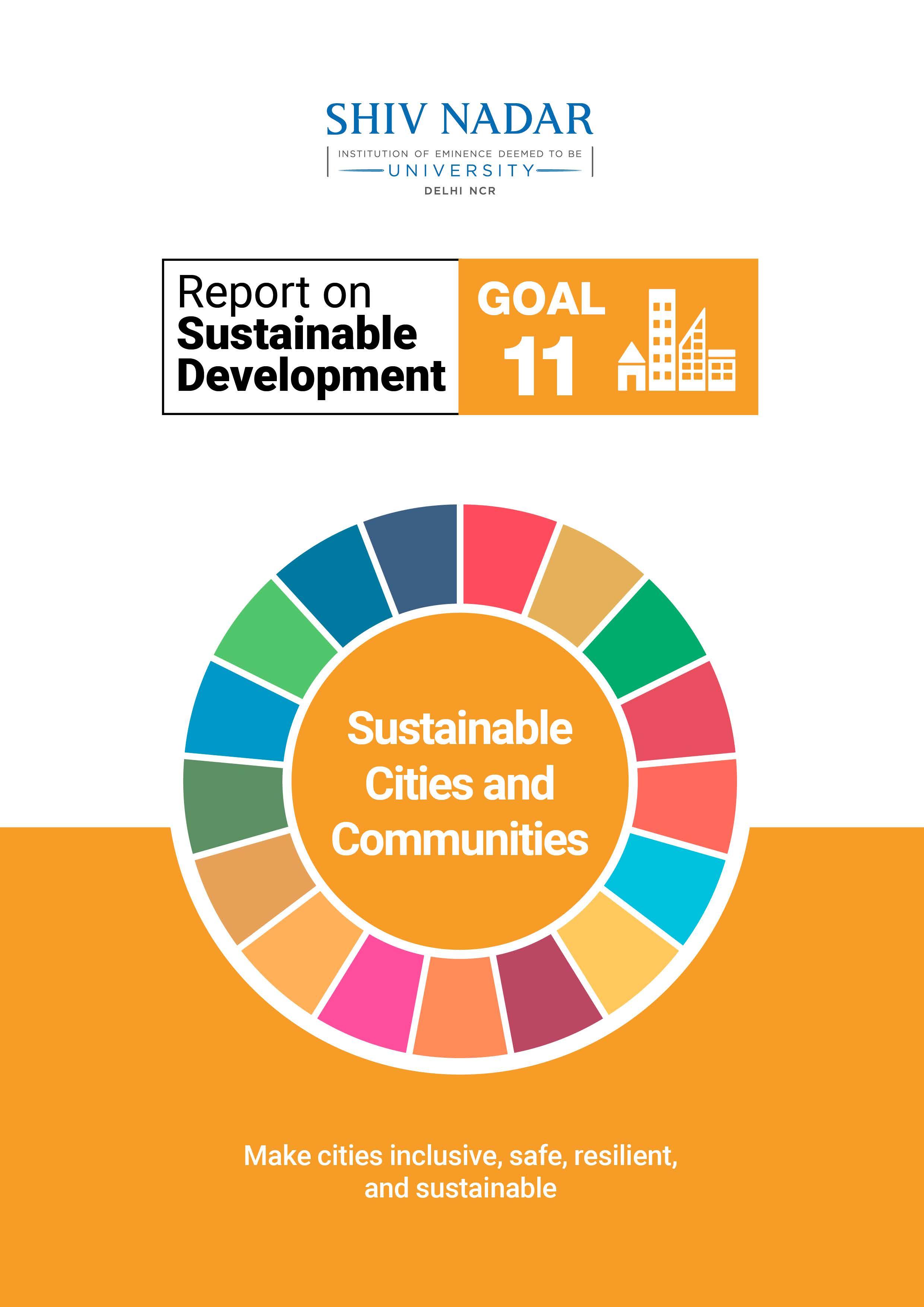

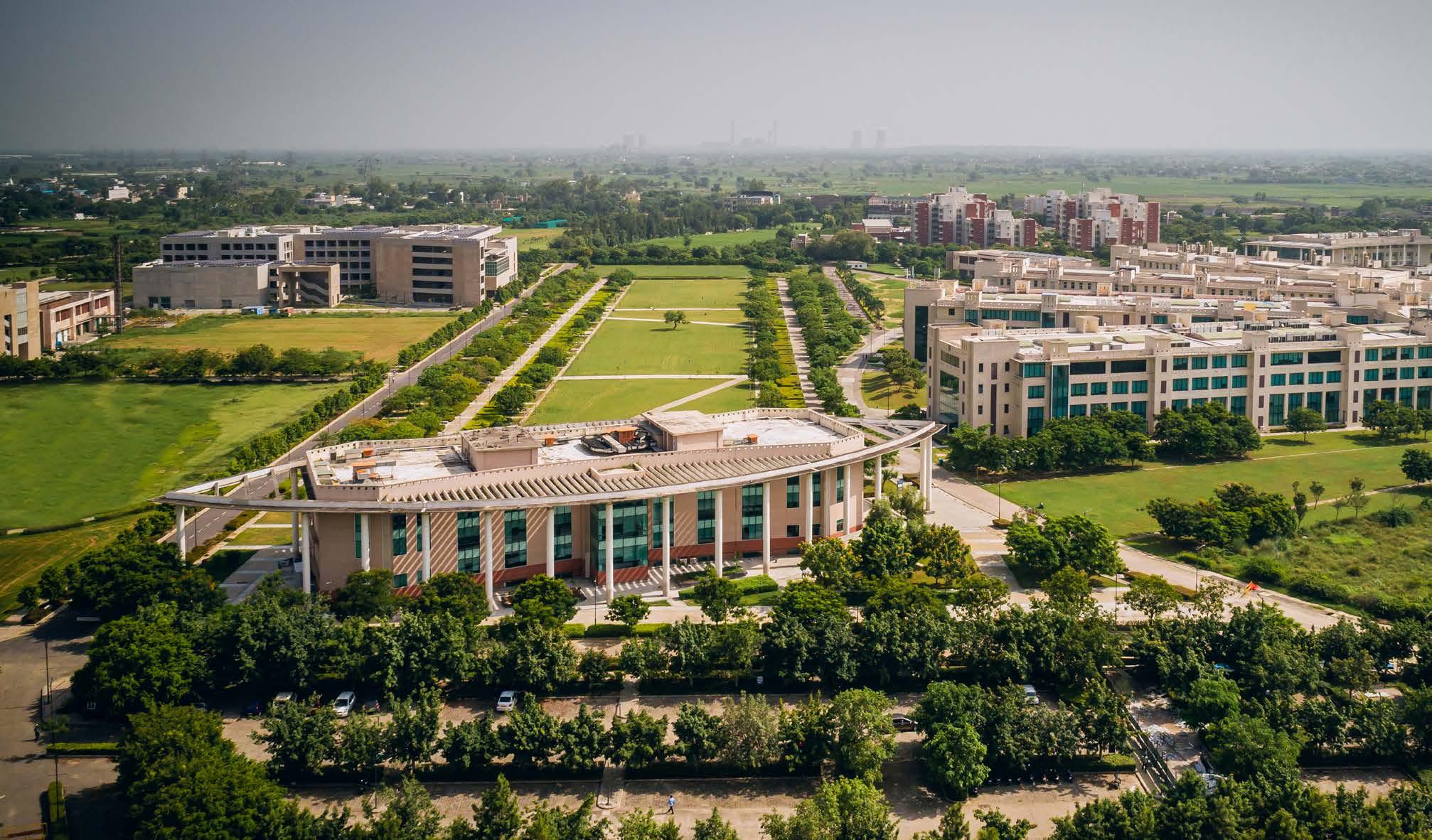
Cities are dynamic places that come to life through the opportunities and innovation they offer, and where inequality also plays a dynamic role. The transformation toward resilient and sustainable societies is to bring about a shift in our patterns of production, consumption, and waste management, and redesign cities to be sustainable.
Universities, in this sense, are places of action where various aspects of sustainable cities and communities are debated and, by their nature, are custodians of heritage and environment in their communities.
At Shiv Nadar, we have an active community working on many aspects of SDG 11 through teaching, research, institutional practices, and partnerships. Here is a glimpse of our work.
TEACHING AND LEARNING
We are committed to offering meaningful education around sustainability and related areas to all students across the university, beyond our core subjects. The School of Humanities and Social Sciences offers many courses at the undergraduate, graduate, and doctoral levels. Some of these courses are Archaeology of Cities (HIS 301), Cities of the Global South (INT 131), Pastoral Nomads and the State (HIS 304), Curating Cultures: Collections, Museums and
Practices (HIS 305), The Anthropology and History of Experts and Expertise (HIS 315), Archaeology of Landscapes (HIS 317), Seeing the Past: Visual Histories and Archaeological Practices (HIS 323), The City and Urban Perspectives (SOC 416), Field, Archive, Ethnography (SOC 602), Art after WWII (Art and Displacement: Migratory Aesthetics in Contemporary Art) (ART 604). For undergraduate students, many compulsory courses are regularly offered, such as Environmental Studies (CCC 704), Biodiversity: Assessment & Conservation (CCC 706), Environmental Impact Assessment (CCC 406), and Energy for Sustainable Future (CCC 614), Use of Energy in our Daily Life (CCC 624), and Green Energy Technologies (CCC613).
Master’s Program in Global Urban
Sociology in partnership with the School of Oriental and African Studies (SOAS), London
Urbanization is of extraordinary significance for the regions in which SOAS and Shiv Nadar University academics focus, and globally, it is a topic that brings together many of the most pressing concerns of our times, from climate, sustainability, to mental health, pollution, illness, and issues of governance and policy.
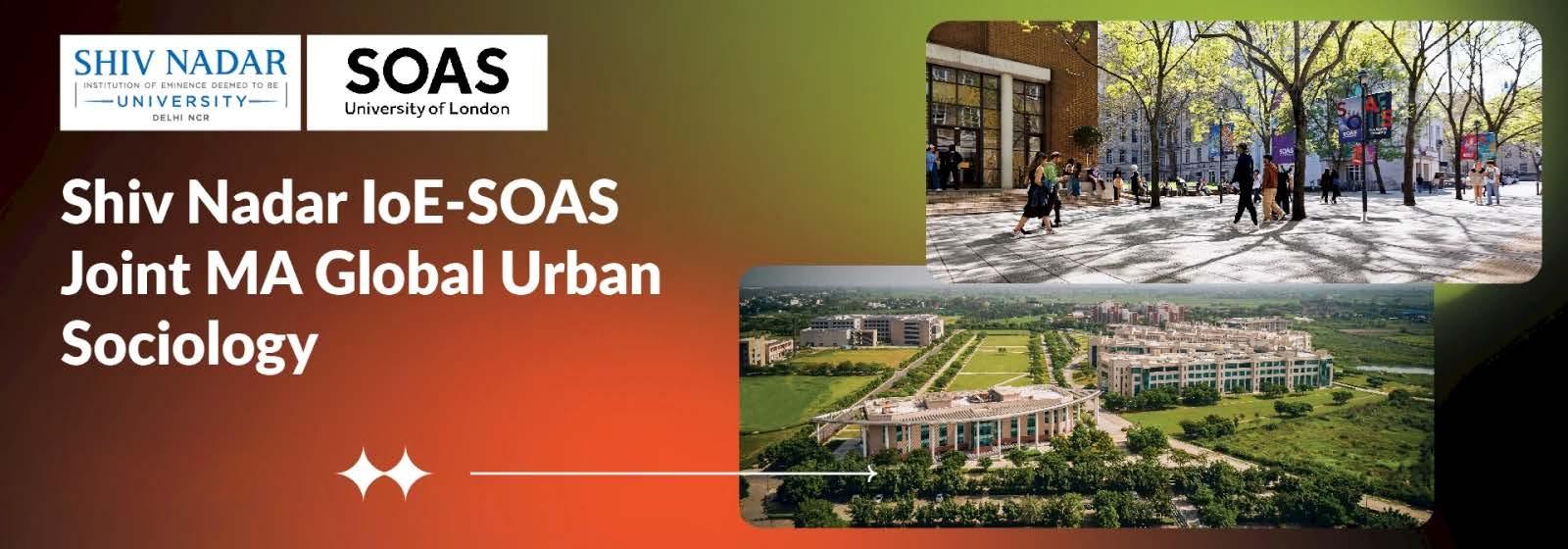
The joint Master of Arts program in Global Urban Sociology provides a unique opportunity for students to grasp the broad global historical/political/cultural canvas against which sociology is studied and how sociology may be useful for thinking about urban global futures. It offers students an option to study current global issues around urbanism with reference to specific case studies drawn from different cities around the world. It also provides an opportunity for students to develop their ability to construct critical evaluations of the applicability of sociological frameworks to ‘real-world’ problems, including in their own research project on the ‘Dissertation’ module.
STUDENT STORIES
Millennium Fellowship Project: Project Himayah
Aanya Anand, a Bachelor of Management Major, received a Millennium fellowship for the class of 2024 for her project that contributes to advancing SDG 11, SDG 17, SDG 7, SDG 12, and SDG 9.
Project Himayah is about decreasing the amount of single-use plastic produced on the campus. The project’s basic framework revolves around a circular economy model involving collaboration among university administration, on-campus food vendors, and established economic organizations dedicated to upcycling such waste. Project Himayah serves as a small yet significant effort to build a community by raising awareness about the importance of sustainable practices.
With an aim to advocate sustainable waste management practices and provide support to ecoenterprises specializing in transforming waste into
valuable products, the initiative seeks to mitigate the environmental impact of plastic waste while simultaneously creating job opportunities to help people from surrounding villages to gain more financial independence.
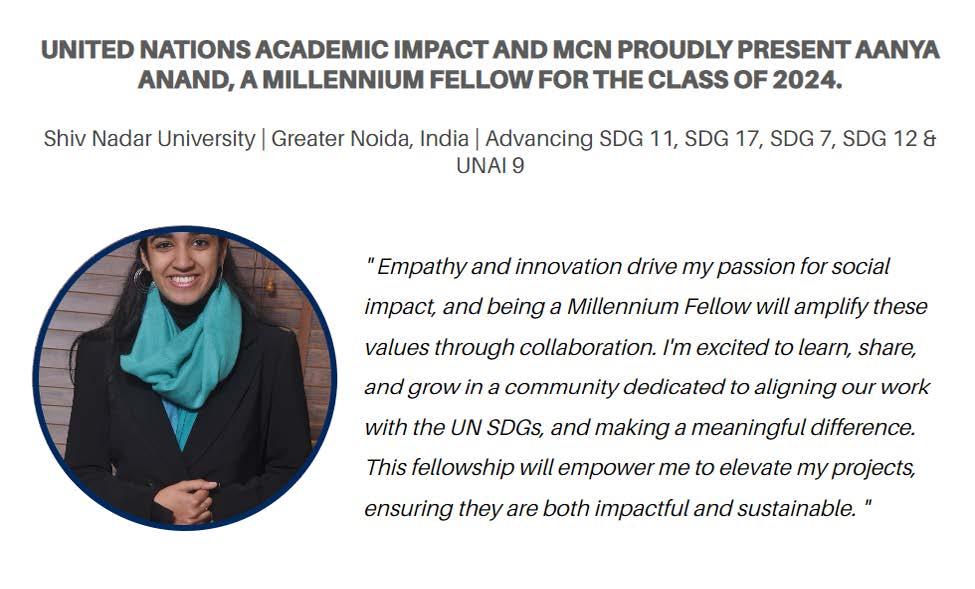
Students of the Master’s in Rural Management celebrate World Indigenous Peoples’ Day
The students of the Master’s in Rural Management celebrated World Indigenous Peoples’ Day on August 22, 2024. The second batch of 45 students consisted of 22 women and 23 men from 10 states and 27 districts across the country. Of these, 17 are Adivasis, including two students from Maharashtra’s Kolam community, a particularly Vulnerable Tribal Group (PVTG).
It was heartening to see the students ideate, conceive, design, and present the event, showcasing the rich diversity of India. Celebrating the event with the huge support of university leadership is a powerful marker of the university’s inclusiveness, diversity, and social commitment.

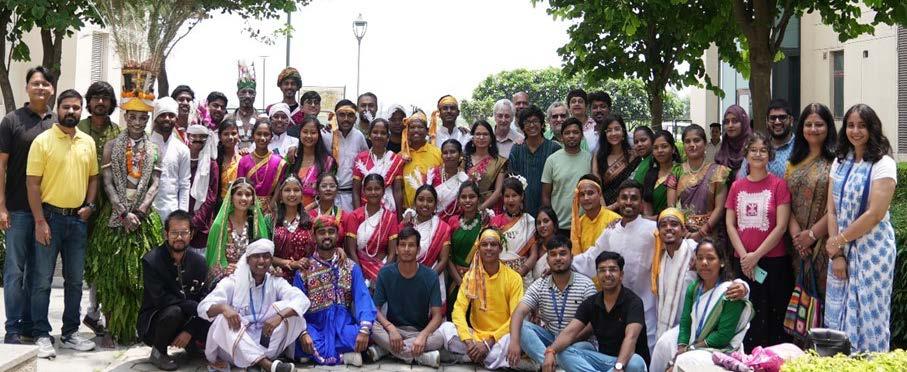
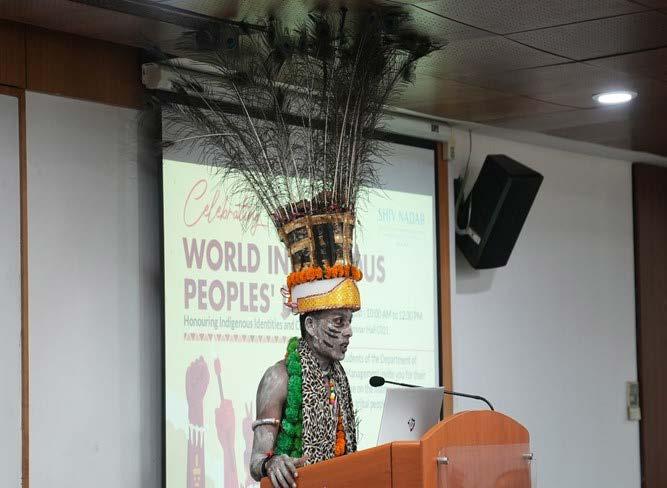
Social Sector Internship - Student Projects
Social Sector Internship is an eight-week rigorous and mandatory internship on real-life projects that provides our undergraduate students the context, empathy, and expertise to make decisions, keeping in mind the triple bottom line involving people, planet, and profit, irrespective of the professional or entrepreneurial roles they assume in the future. These opportunities generate new forms of knowledge where disciplinary barriers are dissolved; the divides between the scholar and the practitioner, the thinker and the doer, are overcome, and concrete societal benefits accompany the academic benefits of research. SSI is contributing toward a world that is healthy, sustainable, just, and inclusive.
The students in the School of Management and Entrepreneurship undergo this rigorous 8-week on-site internship immersion in rural and non-urban ecosystems, working with the local indigenous communities on ameliorating social enterprise
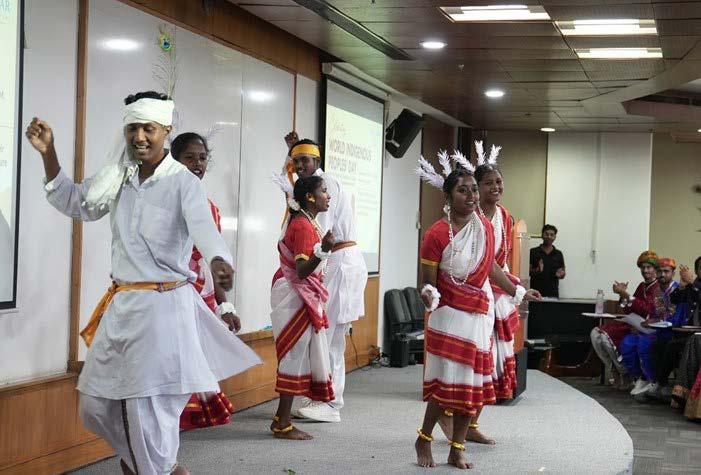
challenges or creating growth models for the social sector.
Some examples of these projects in the area of SDG 11 are as follows: (We can add a box here with these examples).
Mahaneeth Nadimpalli worked with Cyient Foundation on ESG – Key focus areas in community participation. The project entailed evaluating various environmentally sustainable interventions of Cyient for the benefit of the community. The scope involved visiting, interacting with the local community, and measuring the project’s impact.
Navya Jain worked with HCL Tech on the project for the need analysis of slums of Gautam Buddha Nagar for CSR interventions. She extensively conducted field trips and comprehensive geographic analysis of slums in Gautam Buddha Nagar to identify areas for CSR interventions, aiming to improve living conditions, infrastructure, and access to essential services through strategic expansion and targeted support.
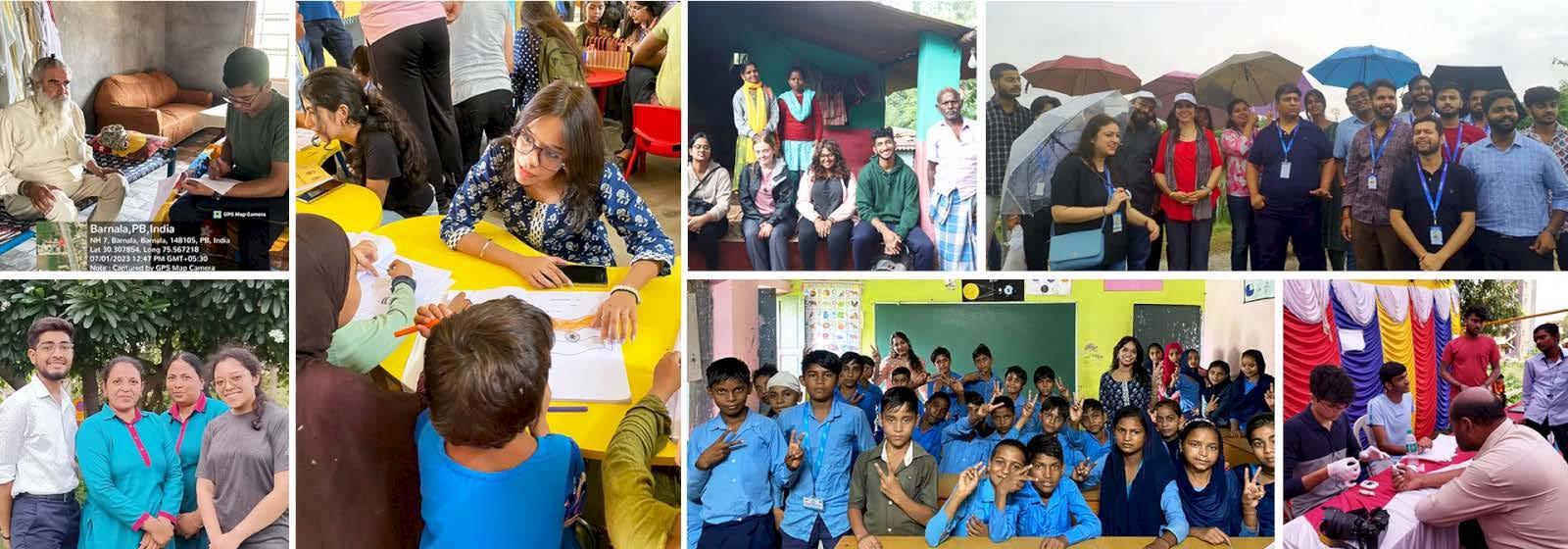
Ronit Ray worked with Access Development Services on the Living Looms of India project. This is a livelihood generation initiative to rejuvenate the domestic Indian Handloom Industry. LLI aims to create employment opportunities for skilled artisans in the handloom sector and train them to become capable and independent of any middlemen. It also aims to bring the handloom industry back to its former glory by promoting made-in-India handloom products produced by the local people.
RESEARCH
Dr. Ghanshyam Pal, Associate Professor in the School of Engineering, is leading research in the Advanced Materials and Building Energy (AMBE) Lab at Shiv Nadar University. His research is on phase change change materials to ensure buildings remain relatively cooler during summer and warm during winters. He has developed a nano-enhanced phase change material system using organic materials, biopolymers, and industrial by-products.
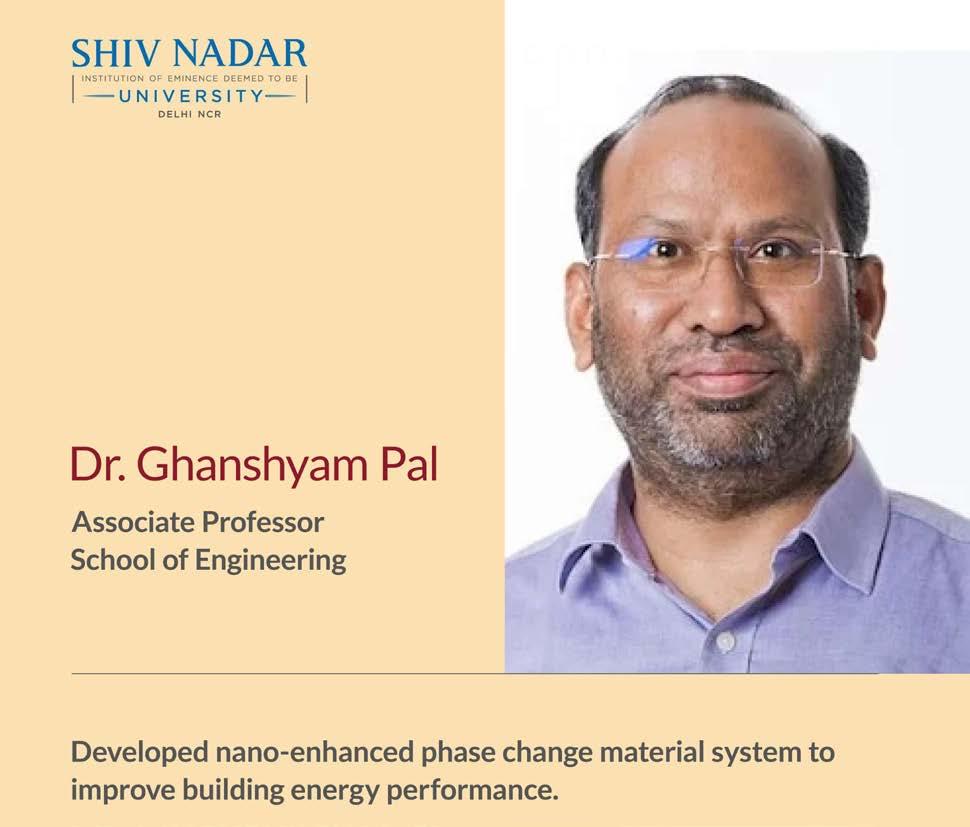

Dr. Pal’s research is directly connected to SDG 7 (Clean Energy), SDG 11 (Sustainable Cities and Communities), and SDG 9 (Innovation and Infrastructure).
Folk Genre of Rural Community
Women: Patrons in Preservation of Folklore
Dr. Tulika Chandra, Professor, Department of English, works with folk narratives. This ongoing project is around semi-urban spaces, such as villages near Shiv Nadar University, such as Chithara, Anandpur, Beel, and Datawali.
This research project contributes to SDG 11 by supporting the preservation of intangible cultural heritage (Target 11.4). Focusing on women’s folk expressions in the semi-urban villages, the project documents, transcribes, and translates oral narratives and folk songs that reflect intergenerational family

dynamics in rural north India. The project helps safeguard community memory and cultural identity amidst increasing urbanisation and socio-economic shifts by archiving these expressions, predominantly those related to community relationships. It also amplifies rural women’s voices, promotes cultural continuity, and contributes to inclusive, sustainable community development by integrating local knowledge into broader scholarly and public discourse.
Pectin biopolymer to develop composite thin films for use as biodegradable wraps for vegetables and fruits.
Dr. Yamini Sudha, Associate Professor, Department of Chemical Engineering, has used pectin biopolymer to develop composite thin films for use as biodegradable wraps for vegetables and fruits. Her research aims to significantly boost the shelf life of produce and reduce hazards to the human body and nature.
The biodegradable wraps are made by extracting pectin from bananas, oranges, and sweet lime. They are a natural, edible coating that can replace synthetic wax, which gives fruits gloss and longevity.
She and her research group have successfully produced small films with improved properties compared to pure pectin films. “We are now working on process-related improvements to scale up the film production with the required physical, chemical, and mechanical properties,” she says.
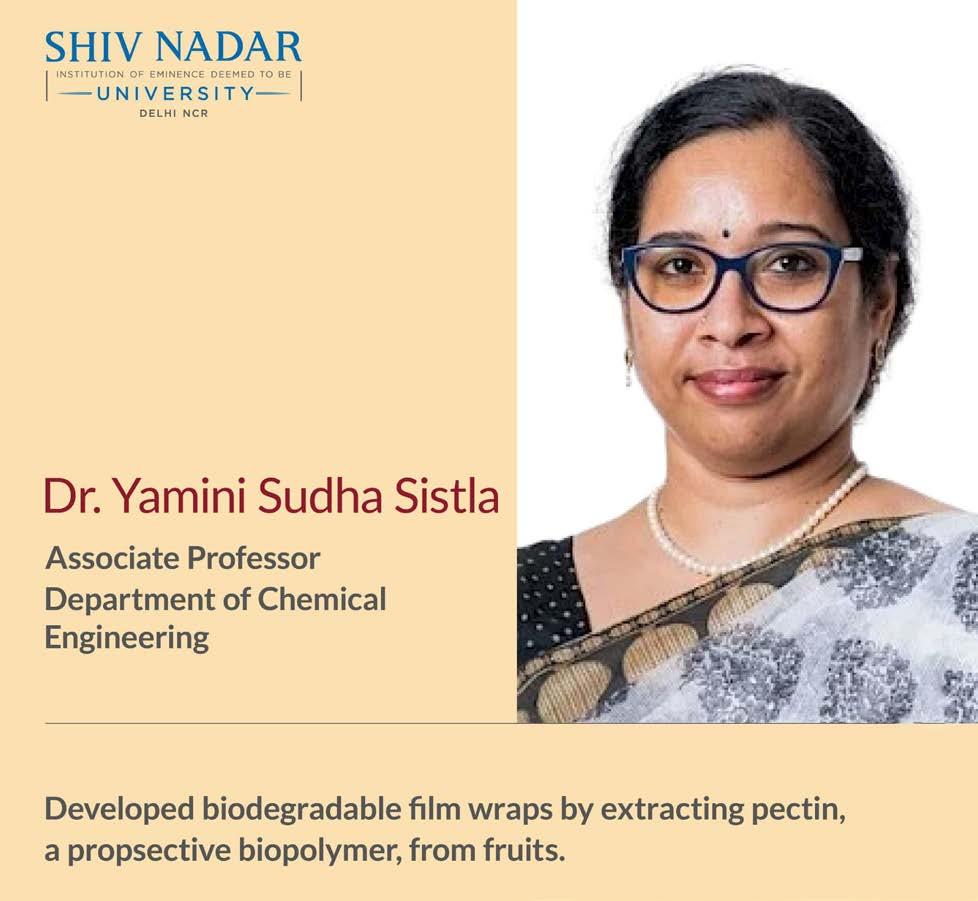
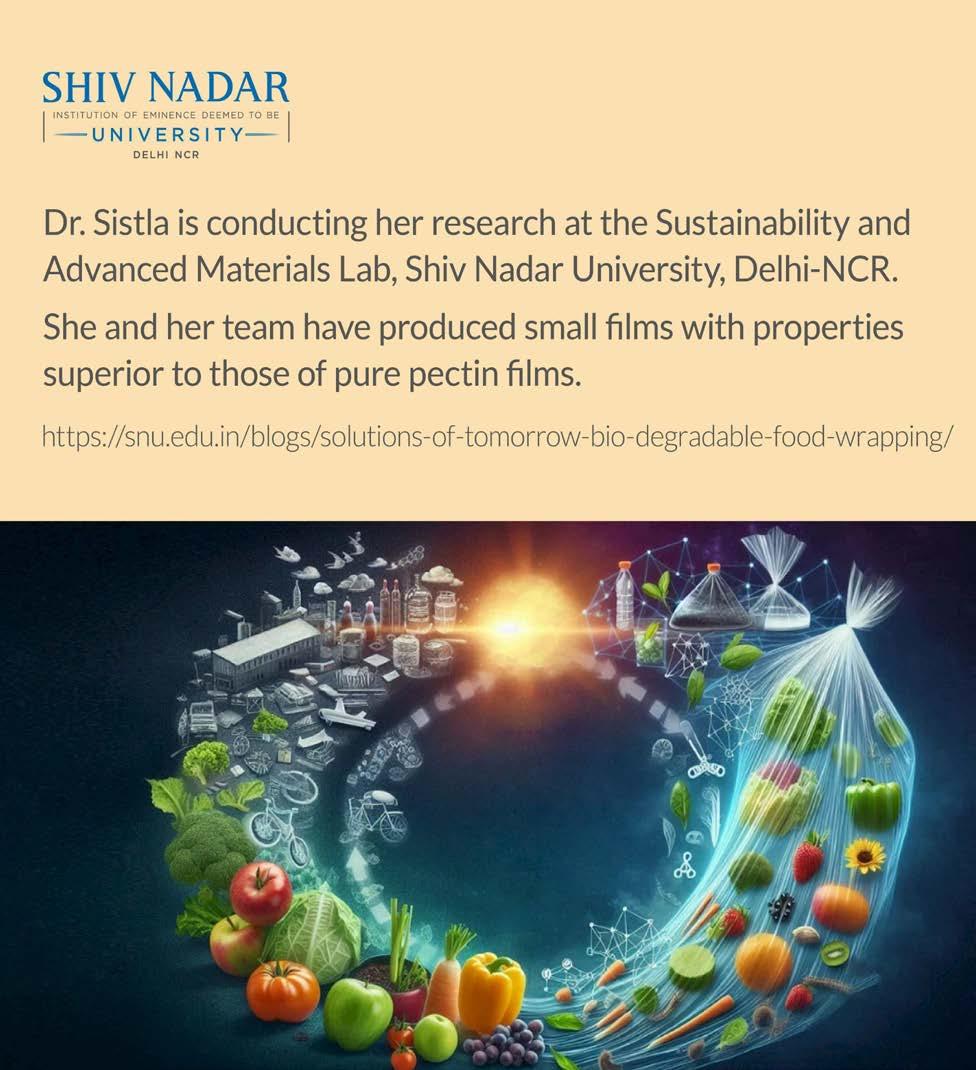
Dr. Sudha’s research is linked to SDG 3 (good health and well-being), SDG 11 (sustainable cities and communities), SDG 12 (responsible consumption and production), and SDG 13, 14, and 15 (climate action, life below water, and life on land).
Earth observations for urban policies and future pathways for urban environmental research
Urban research is evolving, and there are several challenges that need to be addressed, which have led to pathways for further development. The scientific community must consider a multitude of options for urban monitoring, evaluation, planning, and management. In this chapter, the authors provide a brief overview of different models for urban studies and research based on Earth observation datasets. The chapter discusses a variety of potential research areas, including satellite-based monitoring of urban areas, IoT and cloud computing in urban management, and the use of machine learning in urban environmental research.
Ekka, Pawan, Manjari Upreti, Purabi Saikia, Amit Kumar, Prem C. Pandey, and Prashant K. Srivastava. “Earth observations for urban policies and future pathways for urban environmental research.” In Earth Observation in Urban Monitoring, pp. 375-387. Elsevier, 2024.
Campus Talks
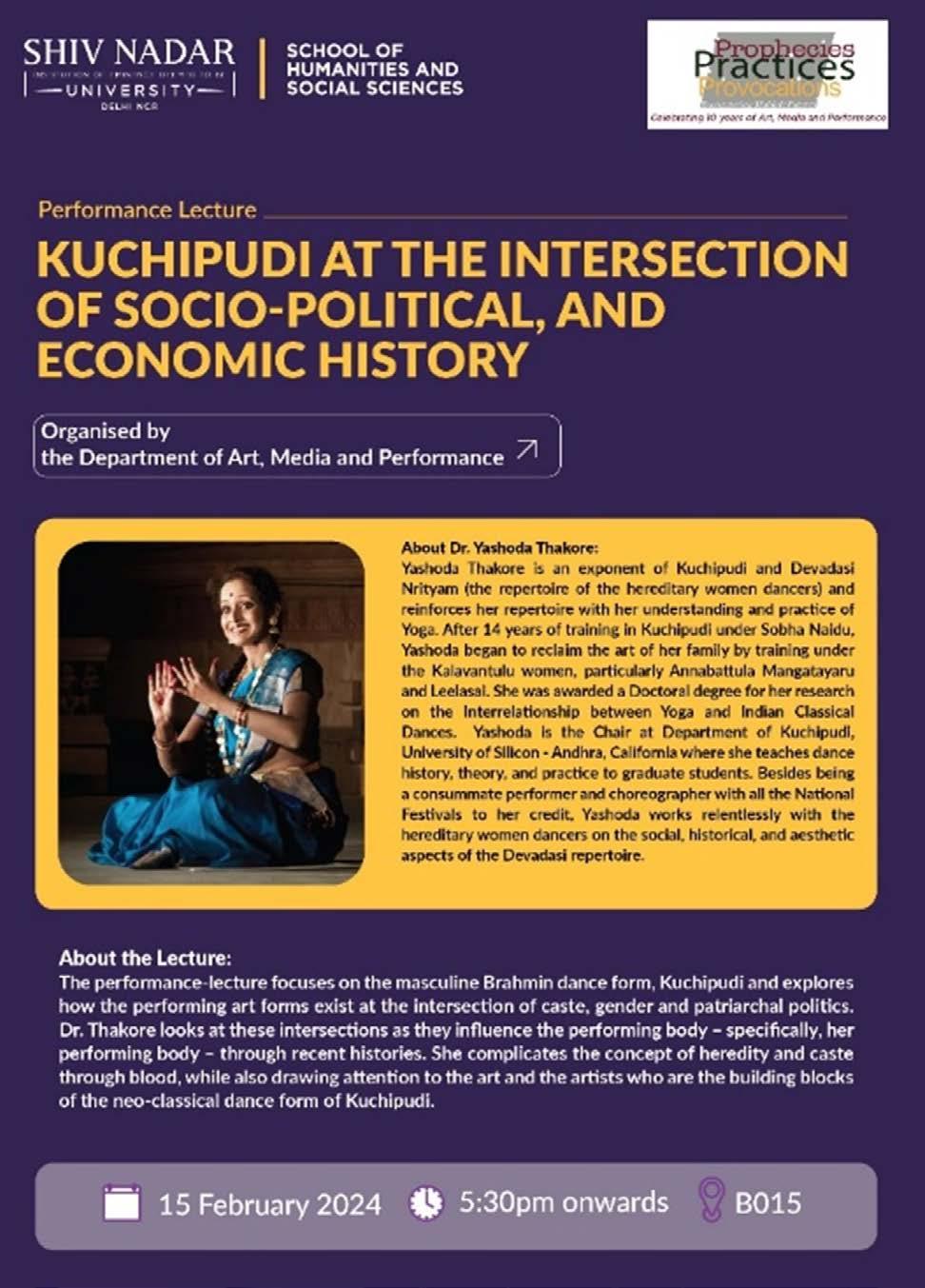
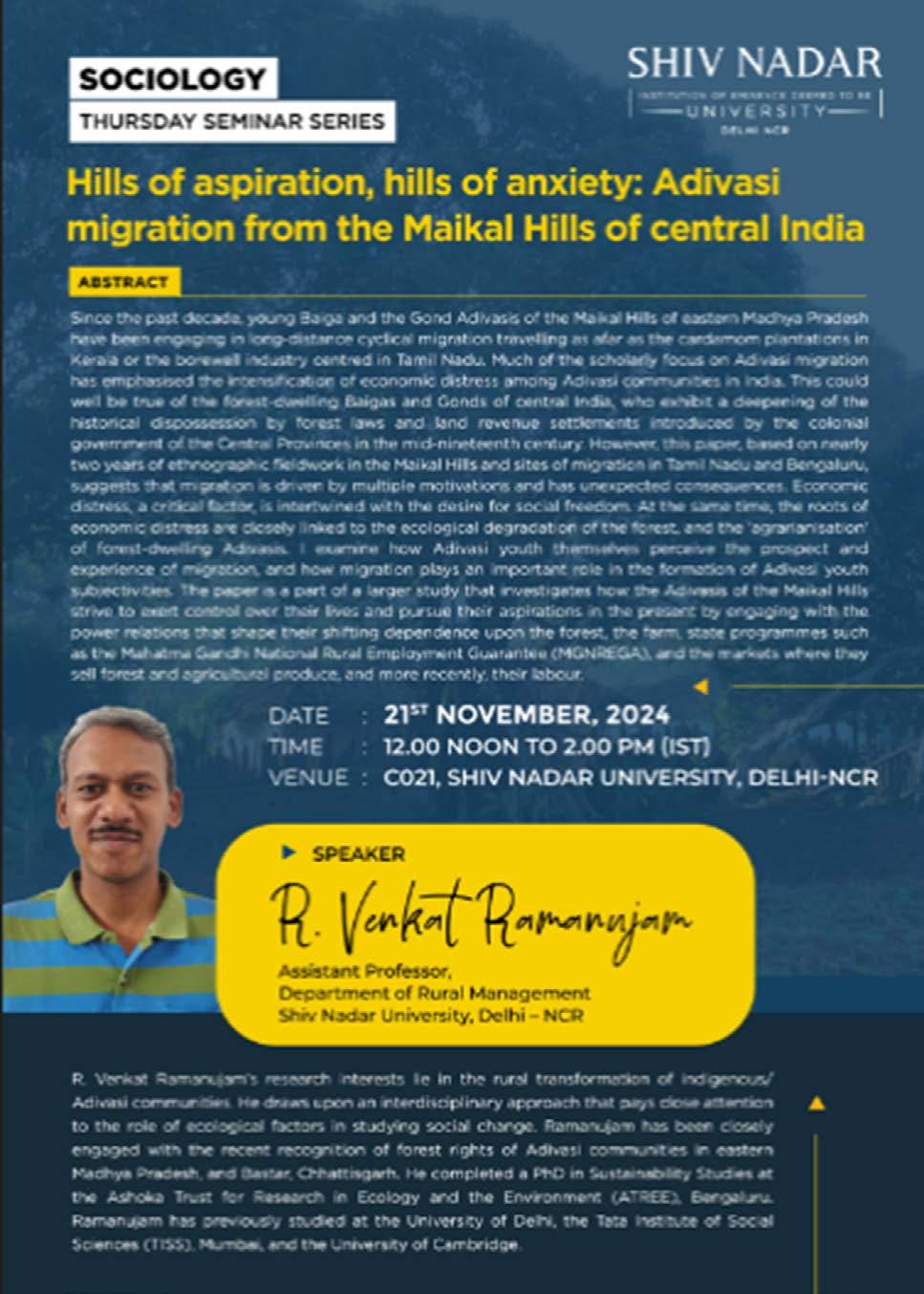

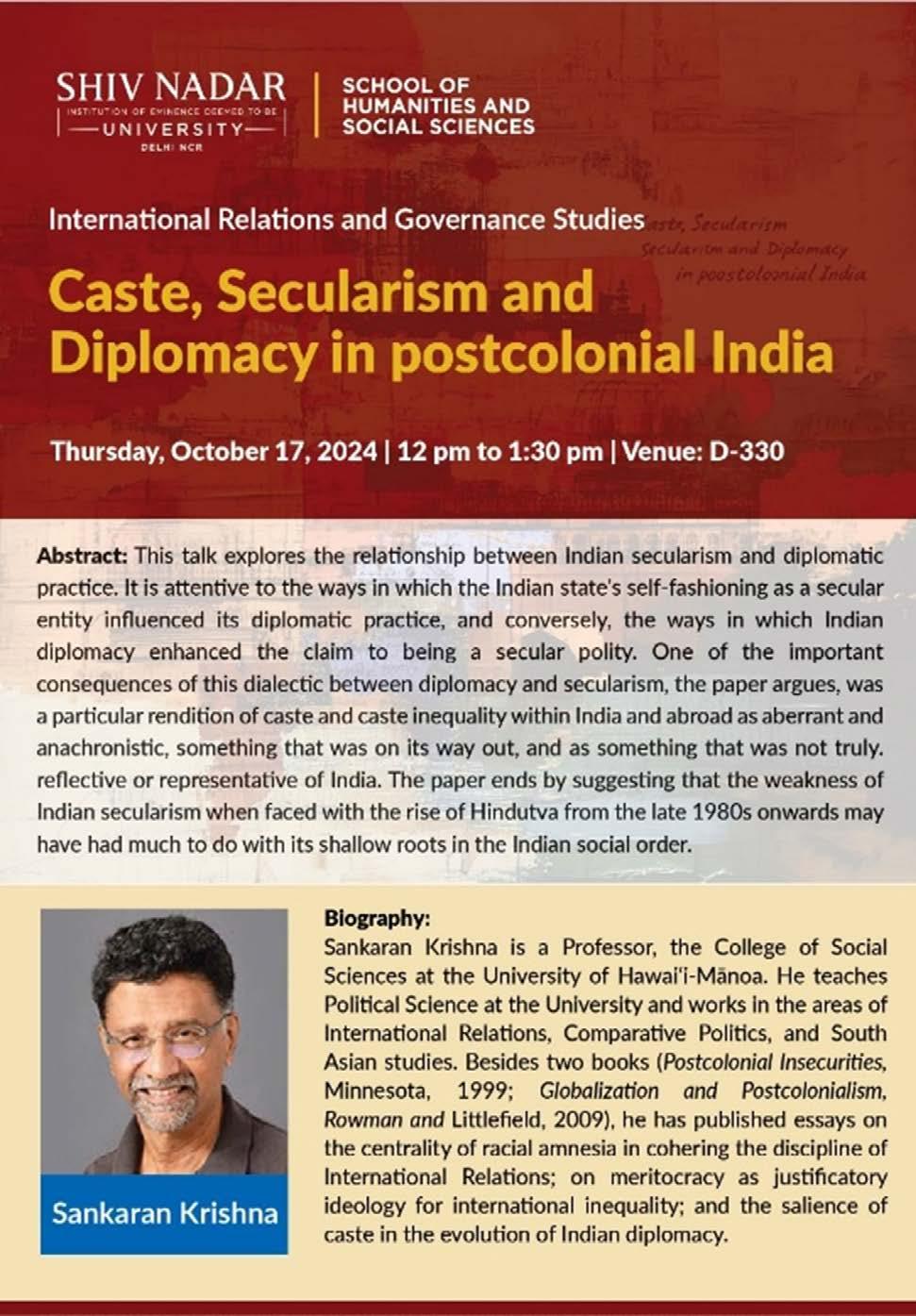


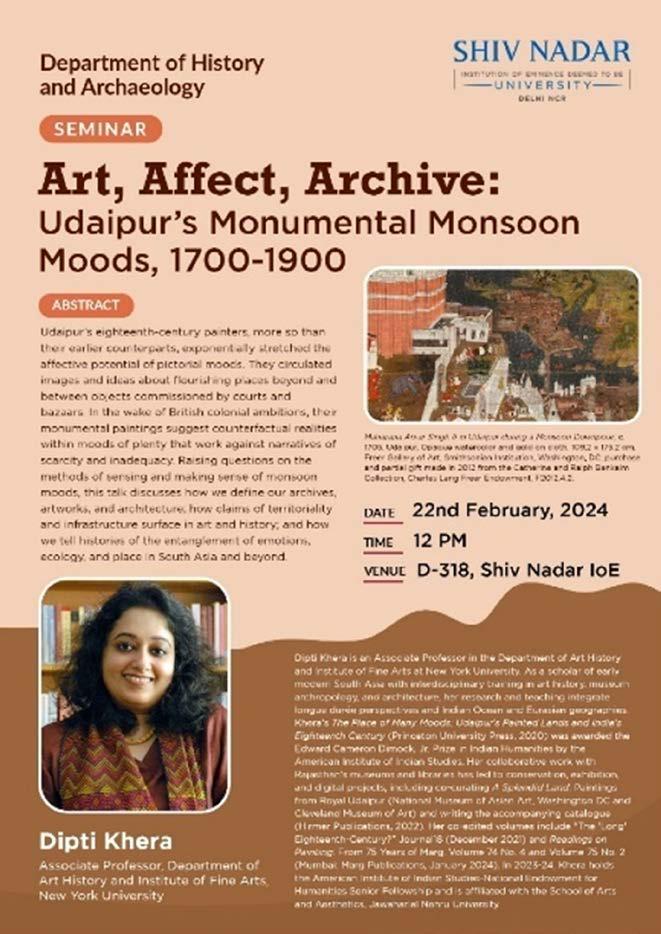
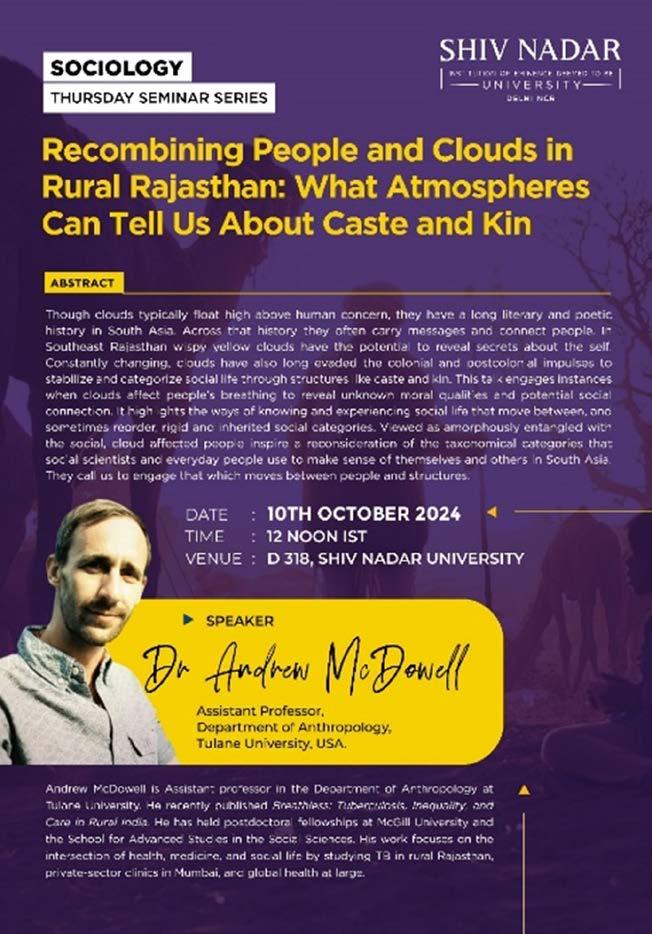

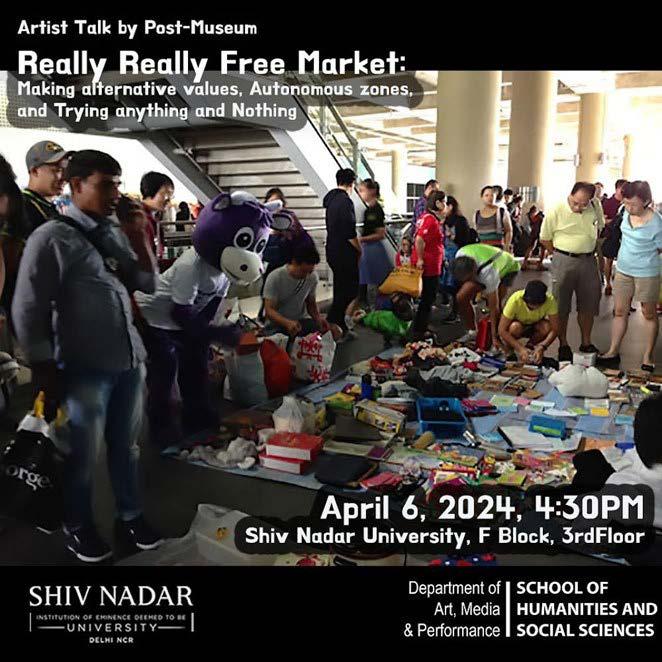


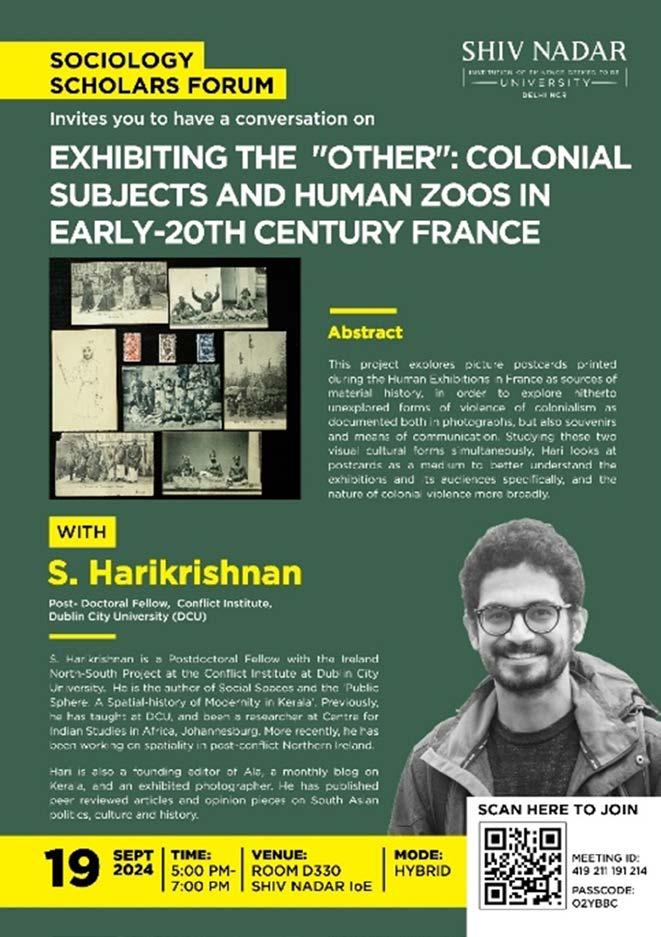
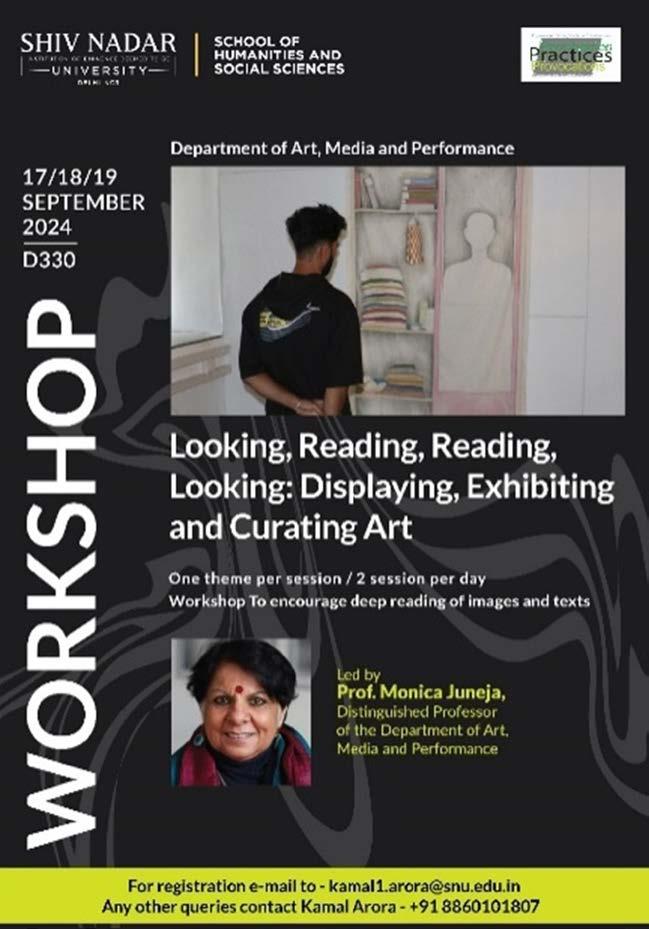
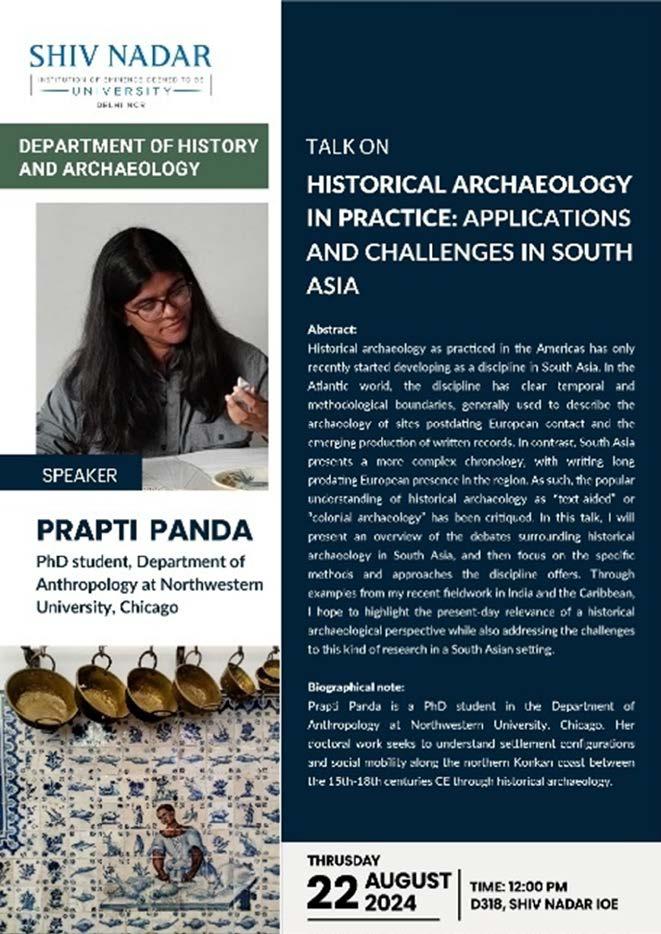
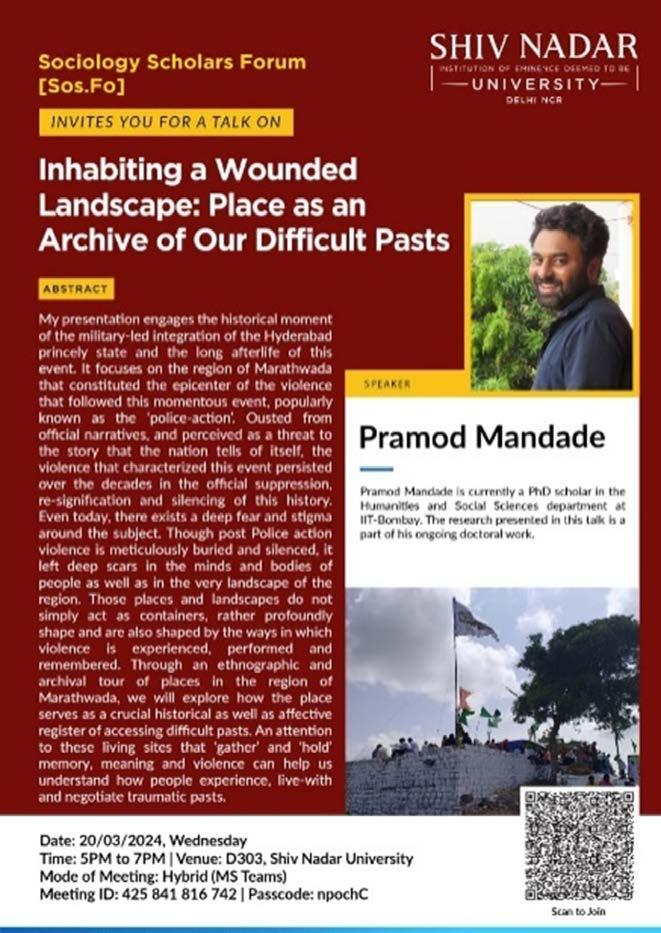

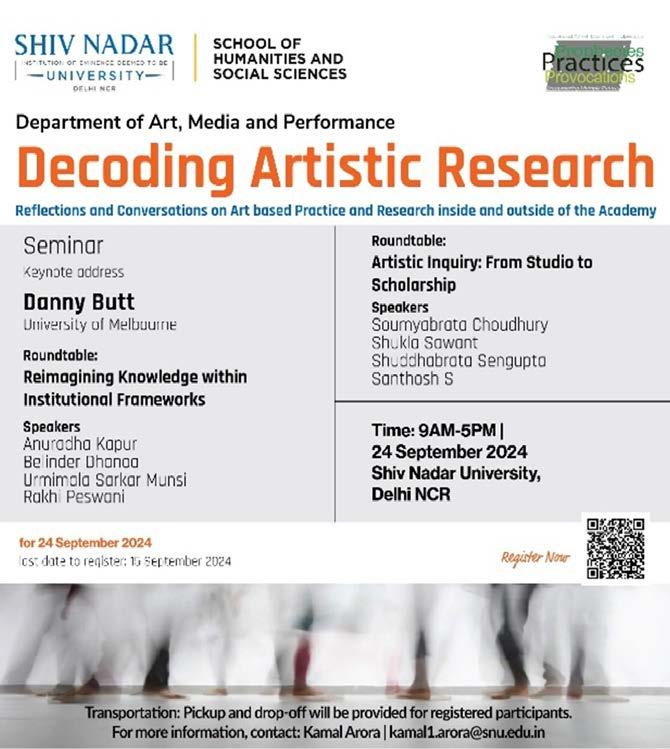
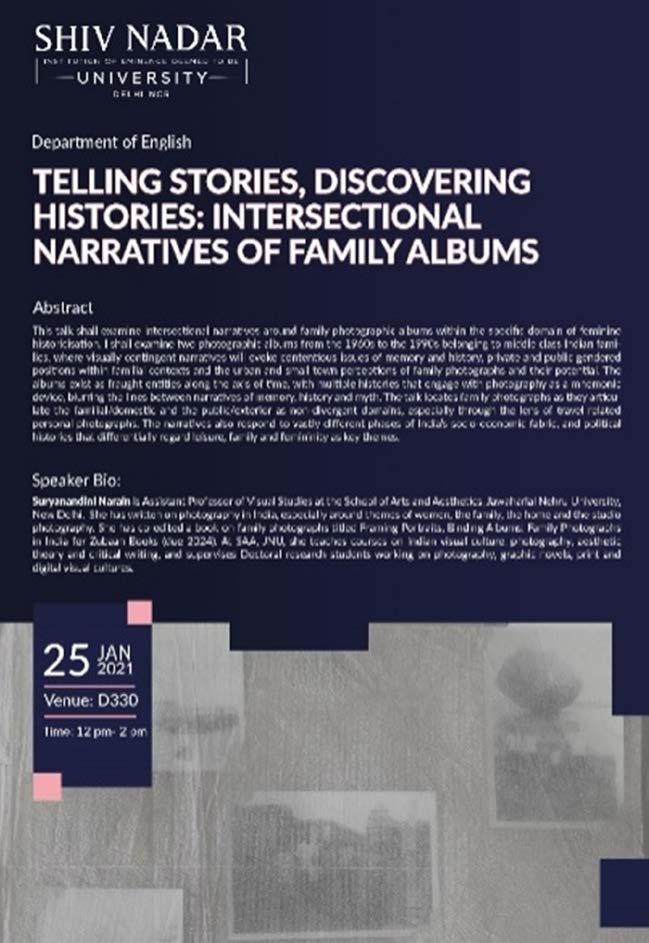
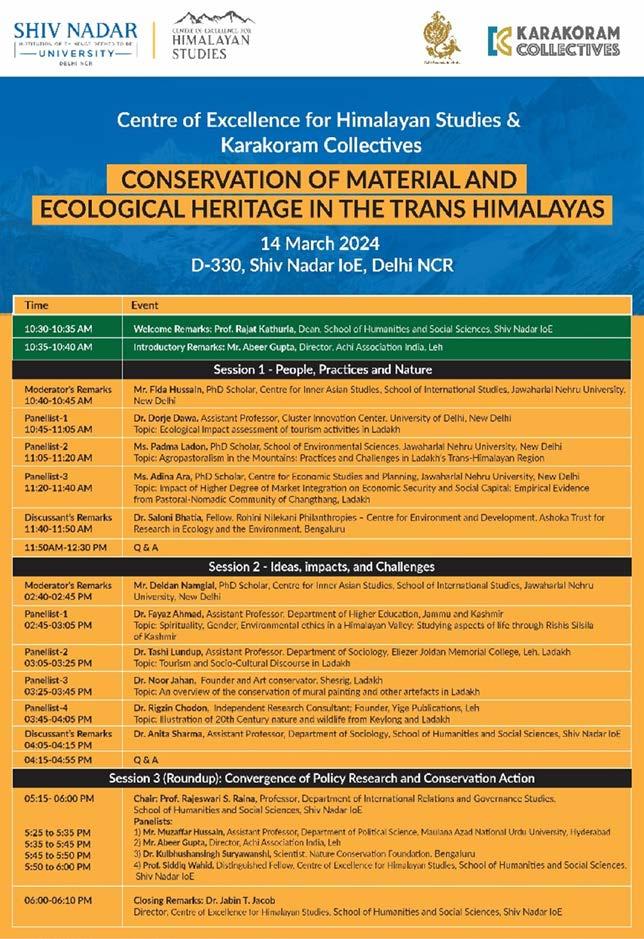
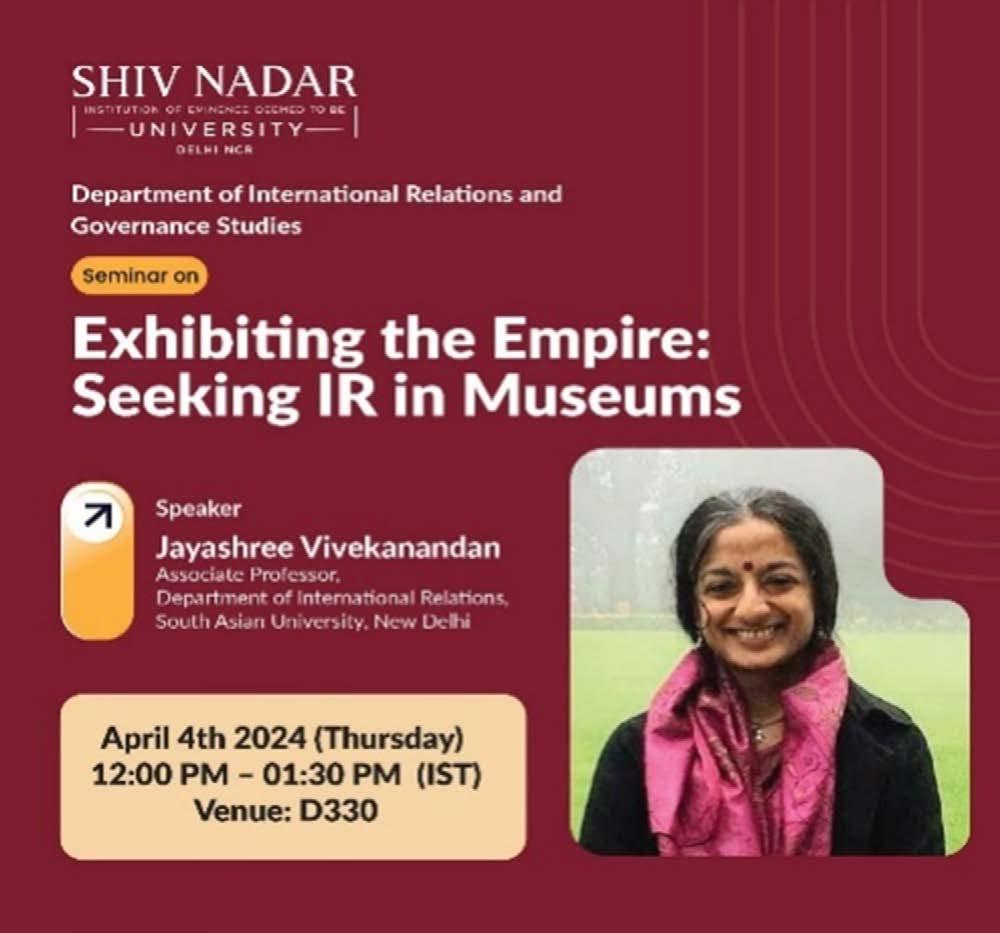

Decoding Artistic ResearchReflections and Conversations on Art-based Practice and Research Inside and Outside of the Academy
The Department of Arts, Media and Performance organized a 2-day seminar on ‘Decoding Artistic Research - Reflections and Conversations on Artbased Practice and Research Inside and Outside of the Academy’ that brought together 150 participants, academicians, and artists from diverse fields to discuss a variety of topics.
The event featured two roundtables on ‘Reimagining Knowledge within Institutional Frameworks’ and ‘Artistic Inquiry: From Studio to Scholarship’. The discussions traced the contours of artistic research and its role within academia. They addressed art practices at the interface between knowledge inside and outside of academia, questions of value, ownership, replicability, and applicability with respect to artistic research.
A workshop on ‘Method and Methodology in Artistic Research’ was led by Dr. Danny Butt, Senior Lecturer in Interdisciplinary Practice, and Graduate Research Convenor for Design and Production at Victorian College of the Arts, University of Melbourne.

UNIVERSITY OPERATIONS
We have undertaken many institutional practices that have contributed to advancing the goal of sustainable communities and cities. Some of these are listed here.
1. Green Building Design and Operations
All buildings on campus comply with the National Building Code, certified by the Indian Green Building Council (IGBC) or Leadership in Energy and Environmental Design (LEED). Several buildings are LEED Gold certified and incorporate green building principles such as natural lighting, efficient insulation, sustainable materials, and low-flow plumbing fixtures, thus making them water and energy-efficient. Besides achieving EHS certification, the university has a policy that promotes environment-friendly and low-emission practices in water, energy, waste, habitat protection, etc. We have also been awarded ISO 14001:2015 and ISO 45001:2018 accreditation without any nonconformance or observation.
2. Renewable Energy on Campus
We have undertaken an initiative to transition to clean energy sources on campus. As part of this, a 1.6 MW solar power plant is installed and commissioned on campus that takes care of as much as 26 percent of the needs of the campus. The goal is to go to 30 percent and beyond.
3. Water Conservation Measures
We have an extensive process for on-campus water extraction and ensure compliance with the daily extraction limit provided by the Central Ground Water Authority (CGWA). We undertake extensive documentation of water usage and reuse. Water is collected through rainwater harvesting infrastructure and reused for horticulture through tanks and pipes for irrigation. Water-conscious planting has resulted in a green campus and reduced irrigation requirements. The campus is home to many droughttolerant plants.
Most buildings on campus are certified by agencies such as IGBC and LEED and comply with extensive
requirements for water conservation. We have obtained the IGBC Gold certificate and meet the LEED ratings, wherein 15% of the credits impact water resources. Other measures include low-flow faucets and toilets, and water-efficient landscaping practices. We have also installed a 500KL sewage treatment plant to reuse water for irrigation and horticulture.
4. Enhance Energy efficiency
We have a system for continually reviewing campus energy use and identifying opportunities for improvement to update our energy consumption analysis and conservation plan. This helps in energy optimization through energy-efficient practices on campus. Many energy-efficient appliances have been incorporated, such as:
• Energy Optimization Monitors in our LEED and IGBC- Gold certified building with integrated sensors, IoT devices, and automation systems for optimized energy use and reduced overall environmental impact
• Effective electric vehicle infrastructure on campus to transition 50% of the car fleet to electric vehicles, increase mobility on campus, and reduce carbon footprint and dependency on fossil fuels.
• Modular sewage treatment plant technology is installed on campus and has a capacity of 734 KLD. The STP treats 550 KLD water from the entire campus, including campus housing.
• Monitoring platforms installed to track energy usage, waste generation, water consumption, and other sustainability metrics to enable informed decisions for continuous improvement
• 1.6 MW solar panels installed on campus across academic and residential blocks to transition from complete captive power and generate clean, sustainable energy on campus
• Energy-saving policy embraced, replacing 11 KV grid power with a 33 KV grid power supply and removing the need to run standby power through diesel generators.
As a part of our Energy Consumption Analysis and Conservation Plan, we review our energy use continually to identify opportunities for improvement. To document the energy consumption of each building, electricity meters are installed in every building, and a complete analysis of energy consumption is reported every month in the “Energy
Performance Index Report.” This helps to check waste continuously.
5. Alternative Mode of transport to achieve sustainable transportation
We are a residential campus for all students and many faculty members. For those who stay outside the campus, a well-planned transport system is in place, and employees are encouraged to be sensitive to their use and optimize their air and road travel. For weekly needs, planned shuttles are provided. To transition to clean power and reduce dependence on fossil fuels, we plan to transition 50% of the car fleet to electric vehicles. The university currently has 60% CNG, 30% petrol, and 10% diesel cars. The plan is that any new inventory added to this would be an electric vehicle.
On campus, we use sustainable transportation options such as walking, biking, carpooling, and public transit. We have a fleet of E-buses and Golf carts with over 150 seating capacity. This, in turn, has helped increase mobility on a large campus like ours and is also a step towards reducing the carbon footprint and dependency on fossil fuels.
6. Biodiversity Conservation
With careful planning, we have nurtured 10.4 acres of land and eco-restored it to create a thematic botanical garden on campus. It is conceptualized as a unique concept and is the first of its kind in
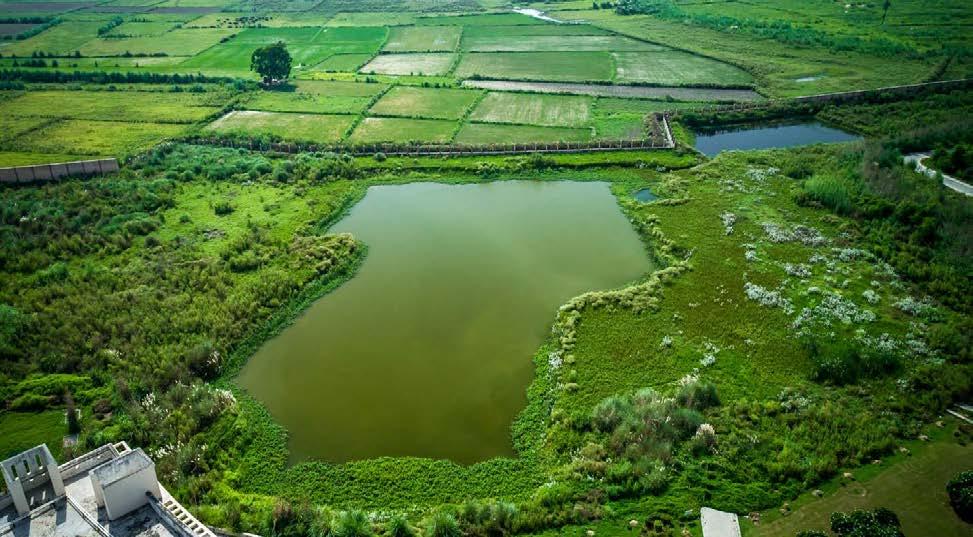
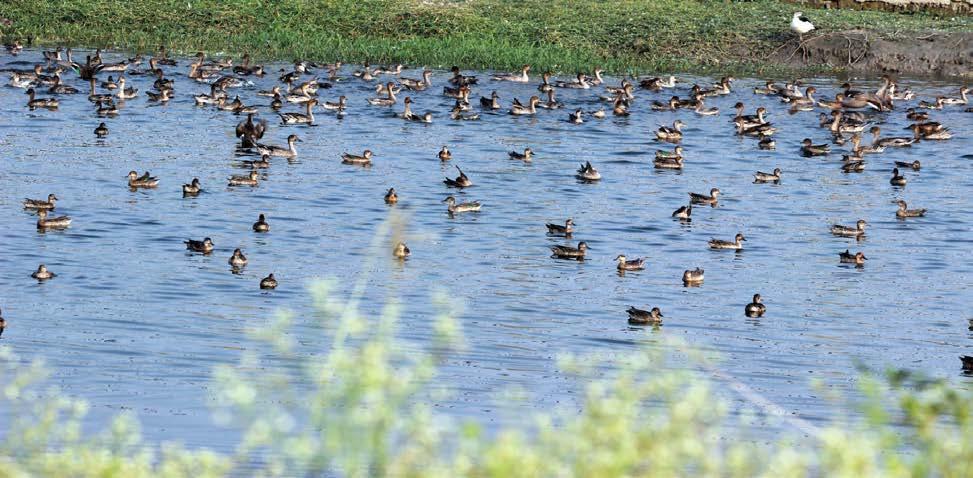

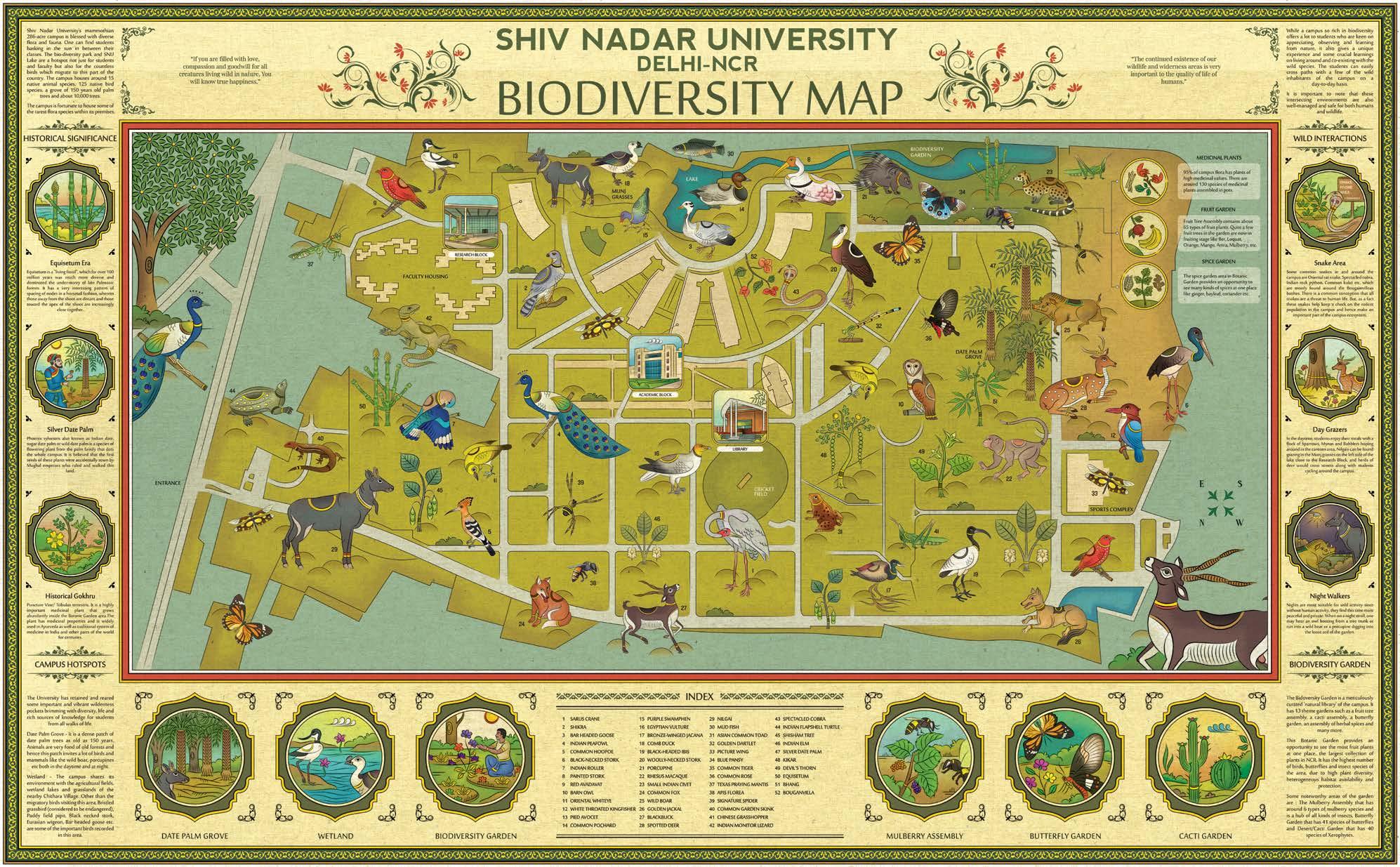
northern India, and provides an opportunity for the visitors to explore plants, which are becoming rare and uncommon, but are economically significant due to various anthropogenic factors that are not observed in any of the botanical gardens except in their native range of cultivation. The garden was also established to increase awareness about the multiple plants we come across daily and to conserve their unique germplasm for education and research purposes. It has about 2000 plants belonging to more than 700 species. The lush green beautiful garden, in turn, has 11 themed gardens with about 555 plant species. The campus is rich in faunal diversity, characterized by a mixture of wetlands and terrestrial species, mammals, aves, reptiles, amphibians, fishes, molluscs, annelids, and insects, including 53 butterflies. These findings and discoveries are published in books for posterity to facilitate research.
8. Sustainable Food Options on campus and Local Sourcing
The University supports the local community with significant economic opportunities and provides fresh and sustainable food choices from local sources to university residents. We have partnered with a local organic farm, Jaivik, where the university sources organic food. The farm is situated within 15
miles of the campus. The produce is procured every week to prepare meals served on campus.
9. Reduce waste and Recycle
We have implemented comprehensive waste reduction and recycling programs to encourage a culture of rethinking consumption patterns on campus. The following are some examples,
• The university has a comprehensive and documented food waste tracking system to measure and monitor food waste at each level, i.e., production, handling, storage, processing, and distribution. Taking efficient measures and maintaining a daily food waste log, we reported a considerable decrease in food waste per person in 2024. This also gives the dining hall vendors a minimum guarantee to keep a check on production, and food waste is used for composting on campus.
• The campus has a restrictive use of plastic. This behaviour is encouraged on campus through communiques and posters for responsible consumption and conservation. Since 2019, plastic waste has been monitored, tracked, and disposed of through green disposal methods. To date, we have achieved a 47% decrease in plastic waste disposal. Wastepaper collection and disposal happen through government-
certified recyclers, which provide recycled paper, paper, and other stationery. Besides, using recycling bins across campus, composting organic waste, and reducing single-use plastics. We have special contracts and systems for safely disposing of hazardous and medical waste.
• Free Store is a student-led initiative on campus to promote recycling. The university community has enthusiastically responded to converting pre-loved clothes into re-loved garments for someone else.
10. Educate, engage, and encourage
• We have set the culture of holding a sustainable convocation, which includes a full spectrum of associated digital experiences, significantly reducing the volume of printed convocation materials.
• The university has its independent program towards energy conservation, renewable energy, and efficiency through reduced consumption in Scope 1, 2, and 3. Besides, we are also developing a road map towards expediting steps to achieve net-zero and become a smart campus in every sense.
• We are carefully integrating principles of SDGs at various levels of education, research, operations, and partnerships. And carefully address the need for leaders and a vision that can inspire a commitment to sustainability amongst all stakeholders in the university and beyond.
• We offer a year-long series of short programs and masterclasses for school students.

PARTNERSHIPS
Digging Into India’s Past at Maski
Maski Archaeological Research Project (MARP), a multidisciplinary initiative dedicated to unravelling the socio-political and cultural dimensions of the multi-period site of Maski.
The MARP is a collaborative endeavour of a team spearheaded by Shiv Nadar University’s Dr. Hemanth Kadambi, Associate Professor, Department of History and Archaeology, Dr. Peter G. Johansen, Associate Professor, McGill University, Canada, and Dr. Andrew M. Bauer, Associate Professor, Stanford University, US. The forthcoming excavation phase, scheduled for the summer of 2025, aims to study Maski’s historical evolution using advanced archaeological methodologies.
This will integrate conventional fieldwork with state-of-the-art technological applications, including remote sensing, geoarchaeological analysis, and digital mapping. This interdisciplinary methodology aspires to construct a more sophisticated and comprehensive understanding of Maski’s historical trajectory and its inhabitants’ lived experiences and adaptive strategies over time.
The Kala Chaupal Trust
Shiv Nadar IoE has signed a Memorandum of Understanding (MoU) with the Kala Chaupal Trust to explore avenues to work on the culture and heritage of Bulandshahr, art, and nature conservation. We are working on several projects to capture the district’s ancient, medieval, and modern stories and narratives. The documentation and on-ground action will support heritage and create a sustainable model for cultural tourism. The collaboration includes student internships, faculty research collaboration in Kala Chaupal’s projects, nature walks, heritage works, and publications.
Community Connect Program to create a model for rural transformation
The Community Connect program is a comprehensive initiative committed to the holistic development of Dadri Block within the Gautam Buddha Nagar District, Uttar Pradesh. Aligned with institutional social responsibility principles, Shiv Nadar University, in collaboration with the

Shiv Nadar Foundation, local authorities, and organizations, aims to bring about positive change through focused interventions that benefit local communities and advance Sustainable Development Goals (SDGs).
One example is the sanitation and waste management drive in Nirmal Datawali, a village adjacent to the university boundary. The project was carried out in partnership with Lending Hands Foundation. While more than 795 residents — including youth, schoolchildren, SHGs, and PRI members — participated in structured awareness programs, key infrastructure like incinerators, bins, and a segregation center was installed, the program received high appreciation for its impact in the following areas:
• Sanitation and waste management improvements through awareness campaigns, waste collection services, infrastructure enhancements, and resolution of waterlogging issues. Waste segregation jumped from 7% to 55%.
• Removal of over 20,000 kg of legacy waste across 10+ identified Garbage Vulnerable Points (GVPs).
• Proper disposal practices rose from 3% to 54%, and door-to-door waste collection access grew from 2% to 89%.
• Establishing a waste segregation centre to promote sustainable waste management
Shiv Nadar University and the Lending Hands Foundation have also signed an MoU under the Dadri Development Program for Phase 2 of the Nirmal Datawali Project.
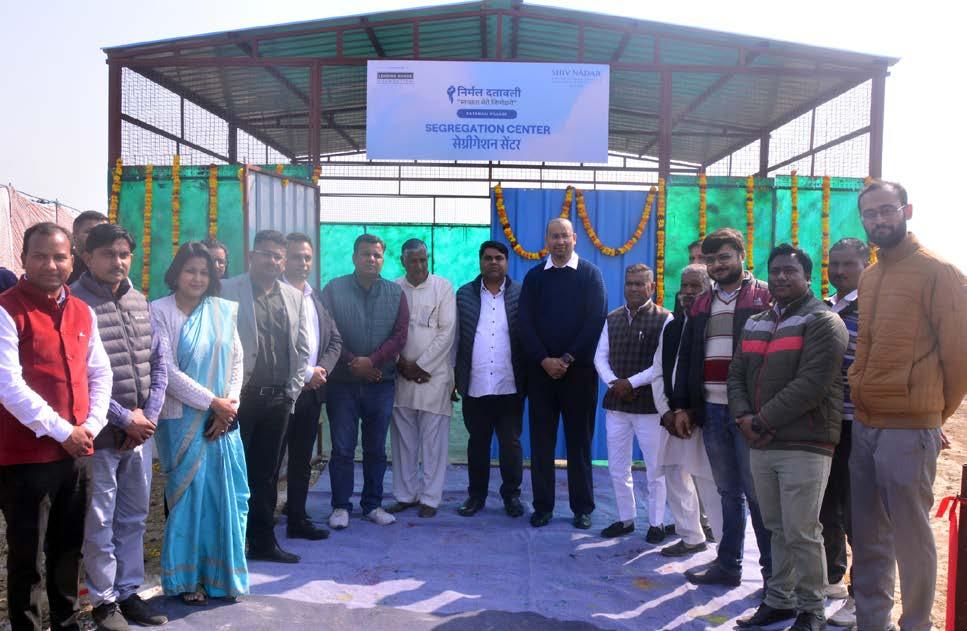
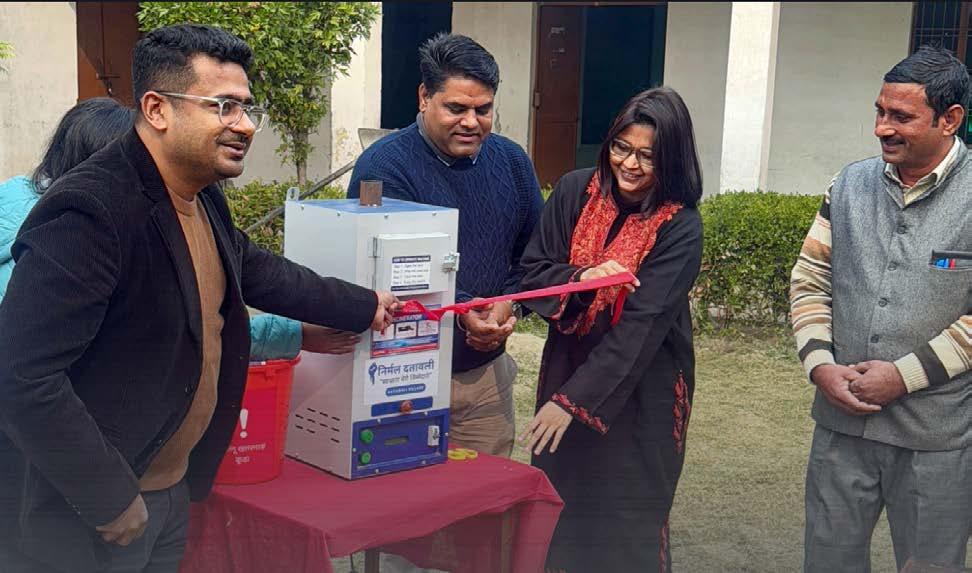
Shiv Nadar Institution of Eminence is fully committed to the UN Sustainable Development Goals (SDGs). We have embraced a four-pronged strategy for SDGs through teaching, research, our core institutional practices, and partnerships.
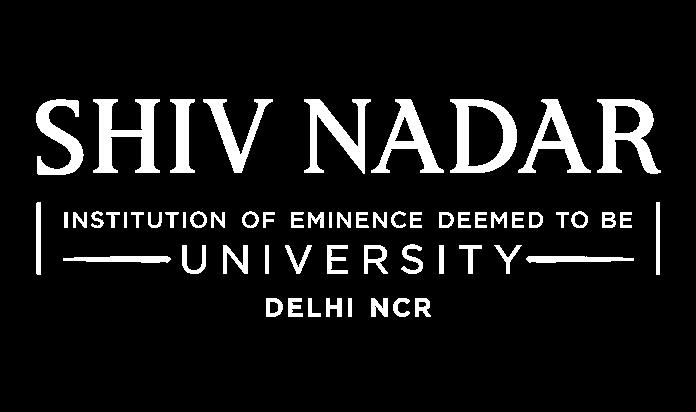
Deepa Hazrati Senior Manager, Office of the Vice-Chancellor deepa.hazrati@snu.edu.in
Shiv Nadar Institution of Eminence Gautam Buddha Nagar, Uttar Pradesh, India
